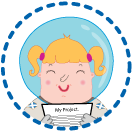

My project

Once you have decided your topic and goal as a class you need to start looking for the things to take your project forward. This stage will explain different types of sources, primary and secondary, through an interactive sorting game.
The downloadable checklist will also help you decide the types of sources you will need for your project.
Now we’ve decided on our topic, it’s time to start looking for the things we need to take our project forward. The key thing we need is information. To get our hands on information, we need to understand the sources of information.
Remember, information isn’t just something that’s written down. Information is all around us. Potential sources of information are anything we can see, hear, touch, smell and taste. All this information is in two main categories. Primary sources and Secondary sources.
So what is the difference between a primary and secondary source? Primary sources are original items like animals, vegetables or rocks. Have a class discussion to see what other examples you can think of.
Secondary sources are things that explain what the primary sources are, like books and films about animals, vegetables or rocks. What other secondary sources can you think of? Discuss it as a group.
Now try to think of sources that are most relevant to your project topic. What kinds of sources might be useful for your topic? And can you tell which are primary sources and which are secondary sources? Discuss this with your classmates, with guidance from your teacher.
Decide which words are primary sources and which are secondary sources and drop them in the right box. When you’ve put all the words away, press ‘SUBMIT’.